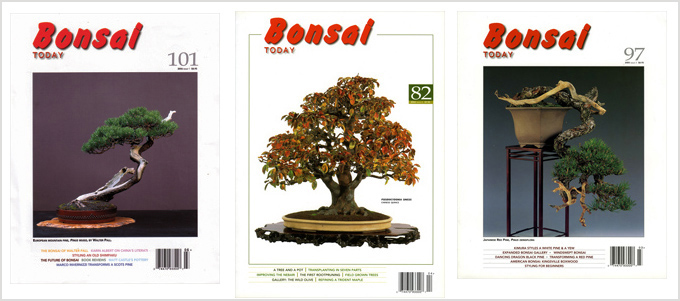 When I first saw this tree I thought it might be a Yew. But, the bark isn’t right, and even the foliage, though close, isn’t quite right either. Fortunately, Peter Tea solved the problem in his 2011 Taikan-ten Exhibition post. Peter’s caption reads: “This
When I first saw this tree I thought it might be a Yew. But, the bark isn’t right, and even the foliage, though close, isn’t quite right either. Fortunately, Peter Tea solved the problem in his 2011 Taikan-ten Exhibition post. Peter’s caption reads: “This Yew Hemlock caught many peoples attention. It made sense that it took the prize for medium conifer. We don’t have any Yews here at Aichien because they don’t do well in the hot weather that we have in Nagoya.”
As for the species, it turns out that there are two Hemlocks that are native to Japan (Tsuga sieboldii & Tsuga diversifolia). My guess is that this powerful and distinctive tree is one of these two. All the photos in this post are from Empire Bonsai.
For now, it’s still Japan
In spite of reports to the contrary, Japan is still the world leader when it comes to bonsai (taking nothing away from Taiwan, Indonesia, Europe or the rest of the world). Not that the situation is not in flux, but all you need to do is take a look at a selection of trees from the major Japanese exhibitions (in the case it’s the 2011 Taikan-ten), and if your eyes are not clouded by chauvinism, you can see for yourself.
One of the raps on Japanese bonsai that you might hear is how it’s become too predictable, even conventional, and that the trees are overly stylized. The problem with this view is that it’s not true (another problem is that it just might be a straw man argument, but I’ll let you be the judge on that). What you see instead, when looking at the best of Japanese bonsai, is a diverse and exciting range of trees, some more stylized, some more traditional, some very innovative and daring, some all of the above, and all marked by a mastery of technique (more on technique at the bottom of this post).
 Trident maple. Among a thousand other things, I like that the lowest branch on the main trunk is in the front and is smaller than branches that are higher on the tree. How many of us would have cut this branch off because convention tells us to?
Trident maple. Among a thousand other things, I like that the lowest branch on the main trunk is in the front and is smaller than branches that are higher on the tree. How many of us would have cut this branch off because convention tells us to?
 I’m going to guess that this strange and wonderful tree is a Needle juniper (Juniperus rigida). Like all the tree in this post, it’s from the 2011 Taikan-ten (photos borrowed from Empire Bonsai).
I’m going to guess that this strange and wonderful tree is a Needle juniper (Juniperus rigida). Like all the tree in this post, it’s from the 2011 Taikan-ten (photos borrowed from Empire Bonsai).
 Something a little different. It’s mostly about the berries with this Firethorn (Pyracantha). When they’re gone, this rock planting will be consigned to a back bench.
Something a little different. It’s mostly about the berries with this Firethorn (Pyracantha). When they’re gone, this rock planting will be consigned to a back bench.
 Looks like a Japanese beech (Fagus creanta). No need to say much more.
Looks like a Japanese beech (Fagus creanta). No need to say much more.
 Same goes with this Satsuki azalea. “No need to say much more.”
Same goes with this Satsuki azalea. “No need to say much more.”
 Want to learn how they do it? Some say that it’s 90% technique and 10% artistry. Bonsai Today magazine is filled with detailed instructions on bonsai technique from the old masters. These benchmark back issues, are now 75% off at Stone Lantern.
Want to learn how they do it? Some say that it’s 90% technique and 10% artistry. Bonsai Today magazine is filled with detailed instructions on bonsai technique from the old masters. These benchmark back issues, are now 75% off at Stone Lantern.
Ironically the second tree with the branch that you pointed out that most would have cut off, and the third tree with the Jin that to me was awkward at best that I would have taken down or off, somehow yet these two trees are in the best bonsai exhibit there is. I guess that’s what makes this an art and not a formula!
I have attended Taikan Ten six of the last seven years. When you have the privilege walking through a show like this, you are seeing the best trees anywhere. The old Japanese trees are stunning. The only thing better is having the opportunity to prepare a tree, enter it in Taikan ten and your tree wins its category.
Hi John,
Yes. Agreed. What is happening at the top levels of Japanese bonsai is often surprising.
Hi Mike,
I take it you live in Japan? Have you entered or tried to enter a tree?
Hello Wayne,
No, I live in Virginia but travel to Japan spring and fall. I spend about two weeks each trip at a satsuki nursery in Nara Prefecture. I travel with several bonsai friends from California and our fall trip is during Thanksgiving, that’s when Taikan ten is held. In 2007 my sensei, Nakayama Suisho, entered one of my trees, a Kikoshi, in the show. The tree was awarded the prize for “Best Small Satsuki”. We leave again at the end of this month and it will be our sixteenth trip.
Thanks Mike and congrats,
It would be great to see a photo of your ‘Best Small Satsuki.’